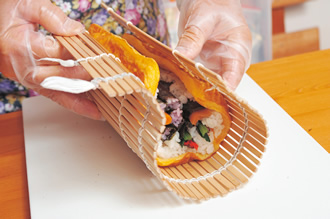niponica is a web magazine that introduces modern Japan to people all over the world.
2018 NO.23
 Tasty Japan: Time to Eat!
Tasty Japan: Time to Eat!

Hana-zushi
Traditional Flower Sushi to Make You Smile
Photo: Ito Chiharu Collaboration: Hanamiyui

Roll up the layer of seaweed or thick fried egg and slice the sushi roll for gorgeous hana-zushi patterns.
Hana-zushi (meaning flower sushi) is a type of rolled sushi in which the ingredients are used to “draw” flowers and other colorful patterns in the rice. On Boso Peninsula in Chiba Prefecture, hana-zushi made with local ingredients is served at festivals, seasonal events, and other special occasions. Traditionally, hana-zushi featured flowers and decorative geometric patterns, but today animals and famous characters are popular with children and adults alike.
Basic rolled sushi—vinegared rice with various ingredients rolled in a sheet of seaweed using a makisu, or mat woven from thin strips of bamboo and cotton string—is said to have originated in the late Edo period (18th- 19th century). These rolls are generally rolled thin with less filling in the eastern region of Japan, where the Boso Peninsula is located, while people in the western region enjoy thicker rolls. Hana-zushi is thicker than the typical rolls of the region, which is why it is thought that the decorative rolls were introduced to the Boso Peninsula by sardine fishermen from further west.
Hana-zushi patterns are generally created using the same ingredients found in regular rolls—long, thinly sliced gourd strips from dried bottle gourd kampyo, pink-colored fish flakes denbu, dried shiitake mushrooms, assorted raw and pickled vegetables, and seaweed or fried egg used to wrap the vinegared rice.
It may look complicated, but hana-zushi is actually quite simple to make. Place a thin sheet of fried egg or seaweed on the bamboo mat and add a layer of vinegared rice, with little mountains from edge to edge. Place desired ingredients between the mountains of rice and use the bamboo mat to roll into a cylindrical shape. Cut the roll into slices, each revealing the same design.
Nearly surrounded by ocean, the people of the Boso Peninsula have long enjoyed seaweed as part of their diet. Chiba Prefecture is also the largest producer of eggs in Japan. Hana-zushi instructor, Miyauchi Masako says, “I use lots of local fresh eggs and wrap my hana-zushi in a thick layer of fried egg.” Hana-zushi is, after all, a special dish that celebrates the natural blessings of the communities where people live.
Hanamiyui in Kamogawa, Chiba Prefecture, offers visitors first-hand experience making their own hana-zushi. In these comprehensive workshops, participants can choose their favorites from among more than 30 types of rolled sushi and learn to roll their own sushi rolls in about an hour. Limited only by their imaginations, students work together to create a variety of patterns in hana-zushi they can take home and eat.
Design your own hana-zushi
- Spread vinegared rice on makisu mat.
Create little mountains of vinegared rice extending from edge to edge. - Cover the mountain ridges with cut sheets of seaweed.
Fill the valleys in with pink denbu fish flakes. Line from edge to edge with cooked vegetables. - Use the makisu mat to roll into a cylindrical shape. Slice.
Create little mountains of sushi rice, cover with seaweed and fill in with red ginger and pink-colored fish flakes.






